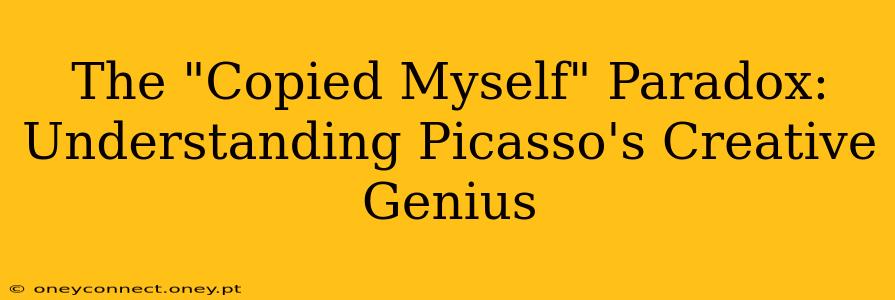Pablo Picasso, a name synonymous with artistic revolution, famously declared, "Good artists copy, great artists steal." This seemingly paradoxical statement encapsulates the complex nature of his creative process, a journey marked by both emulation and unparalleled originality. While he undeniably drew inspiration from countless sources, Picasso's genius lay in his ability to transform borrowed elements into something entirely new, something uniquely his own. This essay will delve into this fascinating "copied myself" paradox, examining how Picasso's creative process defied simple categorization and ultimately cemented his place as one of history's greatest artists.
How Did Picasso "Copy" Others?
Picasso's early career was characterized by a deep engagement with various artistic styles. He mastered the techniques of realism and impressionism before embracing the revolutionary aesthetics of Cubism. This journey involved a profound study of masters like El Greco, Velázquez, and Ingres. He meticulously copied their works, not simply to replicate them, but to dissect their techniques, understand their compositional strategies, and internalize their approaches to form and perspective. This wasn't mere imitation; it was a form of rigorous artistic apprenticeship, a process of absorbing knowledge and developing his own skills.
Wasn't Picasso Accused of Plagiarism?
The accusation of plagiarism occasionally surfaces in discussions surrounding Picasso's work. While he undeniably borrowed elements from diverse sources, the crucial difference lies in his transformative approach. He didn't simply reproduce; he reinterpreted, deconstructed, and reconstructed, merging various styles and influences into a uniquely personal idiom. His appropriation was not about stealing ideas but about engaging in a dynamic dialogue with art history, a continuous process of assimilation and innovation. His Cubist works, for instance, while incorporating elements of African tribal art and Iberian sculpture, were radically different from their sources, demonstrating a transformative power that transcended mere imitation.
What Made Picasso's "Stealing" Different?
Picasso's "stealing" was far from a simple act of copying. It was a deliberate act of artistic appropriation, a method of engaging with existing art to create something entirely novel. His genius resided in his ability to synthesize disparate influences, to take fragments from various artistic traditions and reassemble them into something wholly original. He took inspiration from the past, not to replicate it, but to leapfrog it, pushing the boundaries of artistic expression and creating a new language of visual communication.
How Did He Transform Borrowed Elements into Something Unique?
The key to understanding Picasso's transformative power lies in his profound understanding of form, composition, and artistic expression. He didn't merely copy; he analyzed, deconstructed, and recombined existing artistic elements to create something entirely new. This process involved a deep engagement with the underlying principles of art, allowing him to synthesize diverse influences into a coherent and original style. His ability to infuse borrowed elements with his own unique vision, emotional depth, and innovative technique is what distinguishes his work from mere imitation.
Did Picasso's "Copying" Influence His Later Works?
The early influences remained integral to Picasso's artistic evolution. Even in his later works, echoes of his earlier studies can be seen. However, by then, his unique style had solidified. His "copying" became a method of continuously challenging himself, of exploring new avenues of artistic expression, and of engaging in a perpetual dialogue with art history. This continuous learning and adaptation remained a hallmark of his extraordinary artistic journey.
Conclusion: The Legacy of a Masterful Appropriator
Picasso's creative process, characterized by a sophisticated form of artistic appropriation, defies simple categorization. He didn't merely copy; he transformed, synthesized, and innovated, creating a body of work that continues to inspire and challenge artists and viewers alike. The "copied myself" paradox, therefore, highlights the complex interplay between influence and originality, demonstrating that true genius often lies not in the avoidance of influence, but in the masterful manipulation and transformation of it. His legacy serves as a testament to the power of artistic appropriation when coupled with unparalleled creative vision and technical mastery.

